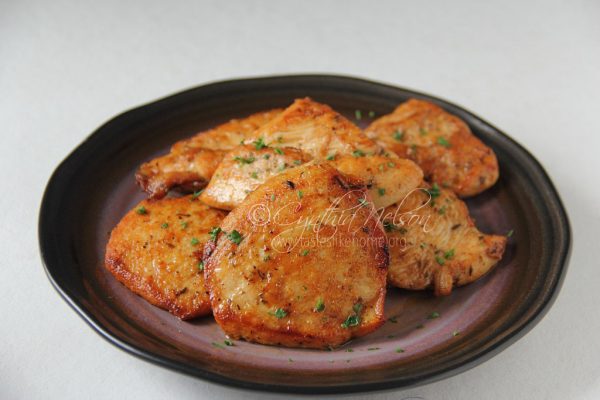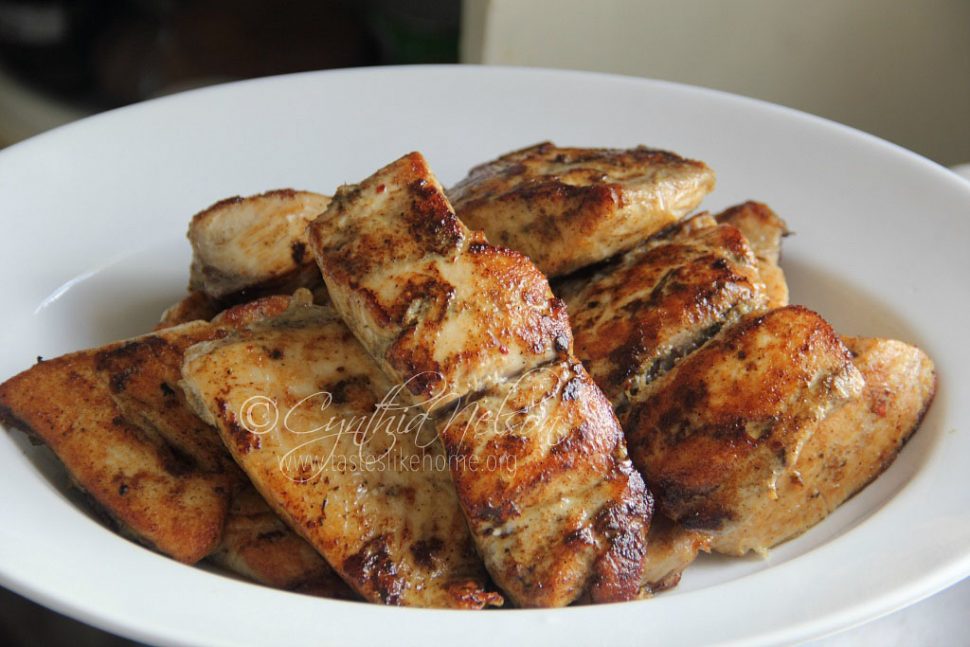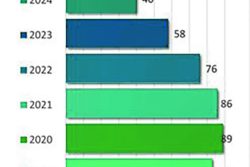 What’s Cooking is a series in which I answer questions and share advice about food and cooking that you have but may be too shy to ask.
What’s Cooking is a series in which I answer questions and share advice about food and cooking that you have but may be too shy to ask.
One of the quickest cooking techniques is pan searing, especially when you want to cook up boneless pork chops; boneless, skinless chicken breasts; fish and prawns. It is the same technique used also when cooking steaks.
To sear means to cook the surface of food at a high temperature until a browned crust forms. Searing is a term used interchangeably with pan searing, but I make a differentiation when cooking certain things. For example, if I am making a pot roast or a stew or starting a roast on the stovetop and finishing it in the oven, I would sear the meat to develop an attractive brown crust then proceed with roasting in the oven or stewing. Pan searing is the term I use when I want to fully cook things on the stovetop like steak, fish, prawns or chicken breasts to serve as an entrée. And that’s the focus of today’s column. You can get food on the table in no time with this cooking technique. Here’s some advice.

The pan
Any type of metal pan can be used, even non-stick. However, if you are after a really rich, brown crust, use cast iron, enamel-coated cast iron, stainless steel, aluminium or hard anodized. These metals can sustain the high temperature heat necessary for good pan searing.
The temperature
The word sear conjures sounds of sizzle, smoke and high heat, and that is exactly what occurs with pan searing. The pan should be on high or medium-high temperature setting depending on your cooker, and it should be heated with oil to coat the bottom of the pan until smoking hot. When the food is added to the pan, it will be noisy and stay that way until the first side of the food is cooked and it is time to flip/turn it. More on that later. I cannot overemphasize the need for the pan and oil to be very hot for successful pan searing.
The protein
It is best to work with boneless fish and boneless chicken breast when pan searing, mainly because these ingredients cook up quickly. Thinly cut loin pork chops work well here too. It is not that you cannot use bone-in steak, cut fish or chicken breasts, however, if you do, you may find the meaty parts drying out because bone-in will need more time to cook or the short cooking time for this technique will result in the meat close to the bone being raw.
Each individual piece of meat or fish should be of the same thickness for even cooking. In other words, one part of the fish should not be thicker at one end than the other. When the fish or meat is laid in the pan, it should lie flat, on both sides. The cooking time for the seafood or meat would vary depending on the type of fish or meat, its thickness, and the size of prawns/shrimp.
Another reason why this cooking technique is excellent for quickly preparing a meal is that the proteins can all be pre-seasoned overnight and brought up to room temperature before cooking. So, you can plan ahead. Planning ahead is not necessary though, you can pick up the stuff in the afternoon and head home and cook dinner. With high quality fresh ingredients, all you need is salt and pepper.
Pan searing
Once the pan and oil are smoking hot, place the fish, meat or prawns – presentation or serving side down first. This is to facilitate the best browning of the sear as the first side takes longer to cook. Be guided by the recipe used for timings.
If you are cooking in batches, you will need to add a little more oil in between each batch, however, ensure that the pan comes back to a high temperature before you proceed with cooking. If you do not do this, you will find the meat or seafood not browning as it should and it can cause moisture to be released from the food, stewing rather than searing it.
When pan searing, you’ll know that the meat or fish is ready to be turned if when you put the tip of a flat spatula to push under it and the meat or fish releases easily; if it doesn’t let it continue to cook for another minute and then try again. Do not force the spatula by digging away beneath food thereby leaving whatever crust has been formed, stuck at the bottom of the pan. This is a good time to remind you that you need to ensure that the pan and oil are very hot to the point of smoking before adding the seafood or meat.
There are visual cues to look for in determining when one side is cooked or not. For example, with fish, if you look at the sides, you can see them turn white, almost opaque, as the heat rises. When that whiteness is halfway to three-quarters way up, flip and let it finish cooking on the other side. It is the same with chicken breasts, you will see the sides of the meat change colour as it cooks. Shrimp too.
It is important to note here that the first side always takes longer to cook than the second side when flipped. For example, you may cook on the first side for 2 minutes, but only need 1 minute on the other side to finish cooking. There is also something called carry-over cooking that factors in. What this means is that when the fish or meat is removed from the pan, it will continue to cook for another 30 seconds to a minute for a perfect finish.
Just as with frying, when pan searing, do not overcrowd the pan, give each piece of seafood or meat enough room to cook on its own. If the pan is overcrowded, it will drop the temperature in the pan and food will release moisture and start to stew and overcook; there’s no pan searing taking place there.
Equipment and cooking times
I recommend using a flat spatula instead of a pot spoon for turning/flipping the fish because you want to be able to slide the spatula beneath the food. For chicken, pork chops and prawns, you can use tongs.
Don’t forget, if there is resistance when trying to turn the food from the first side, let it cook for another 30 seconds to a minute and try again.
Do more than make a stew, curry, braise or roast, try pan searing for a quick and tasty variety to your mealtime.
Cynthia








